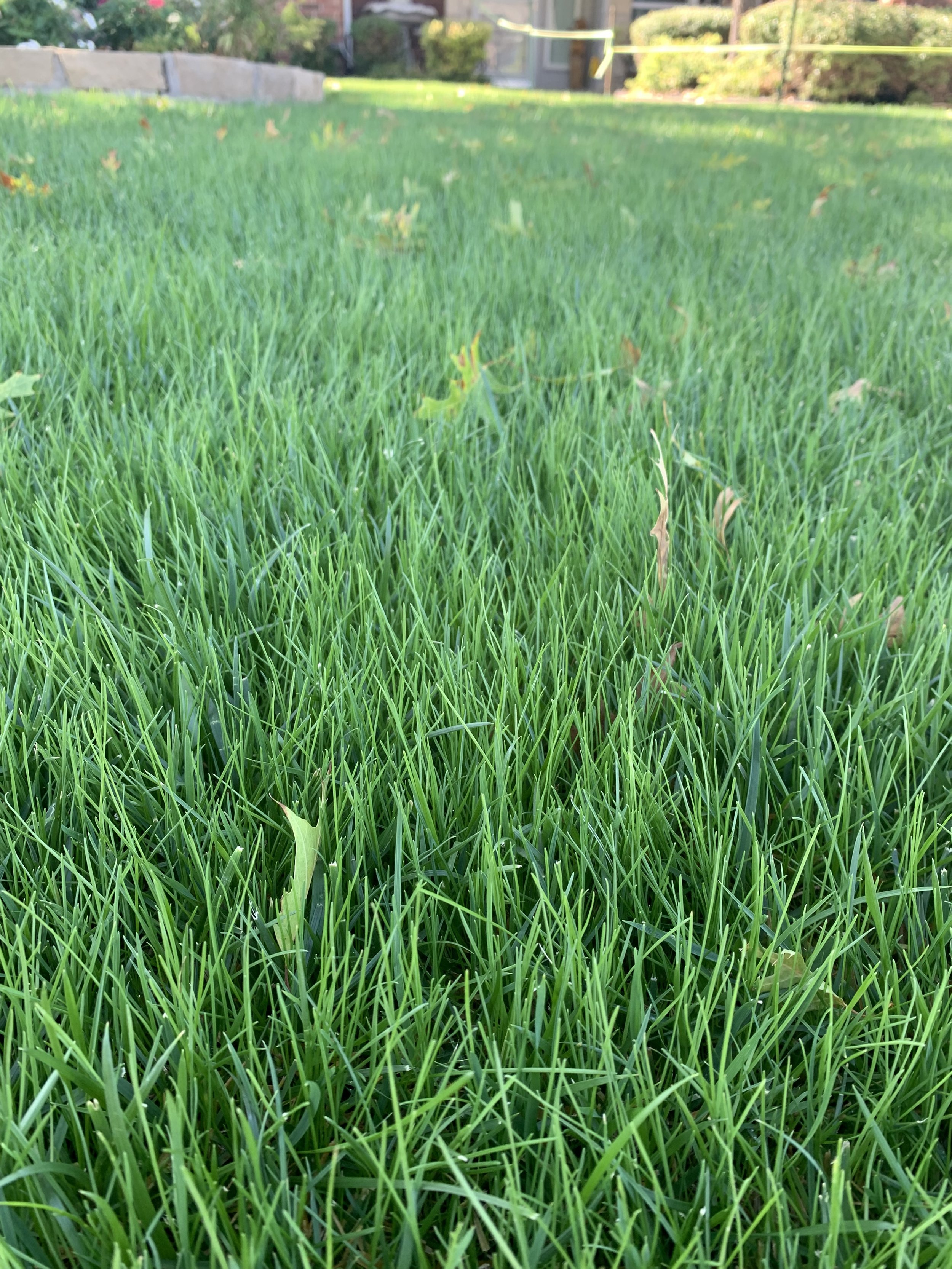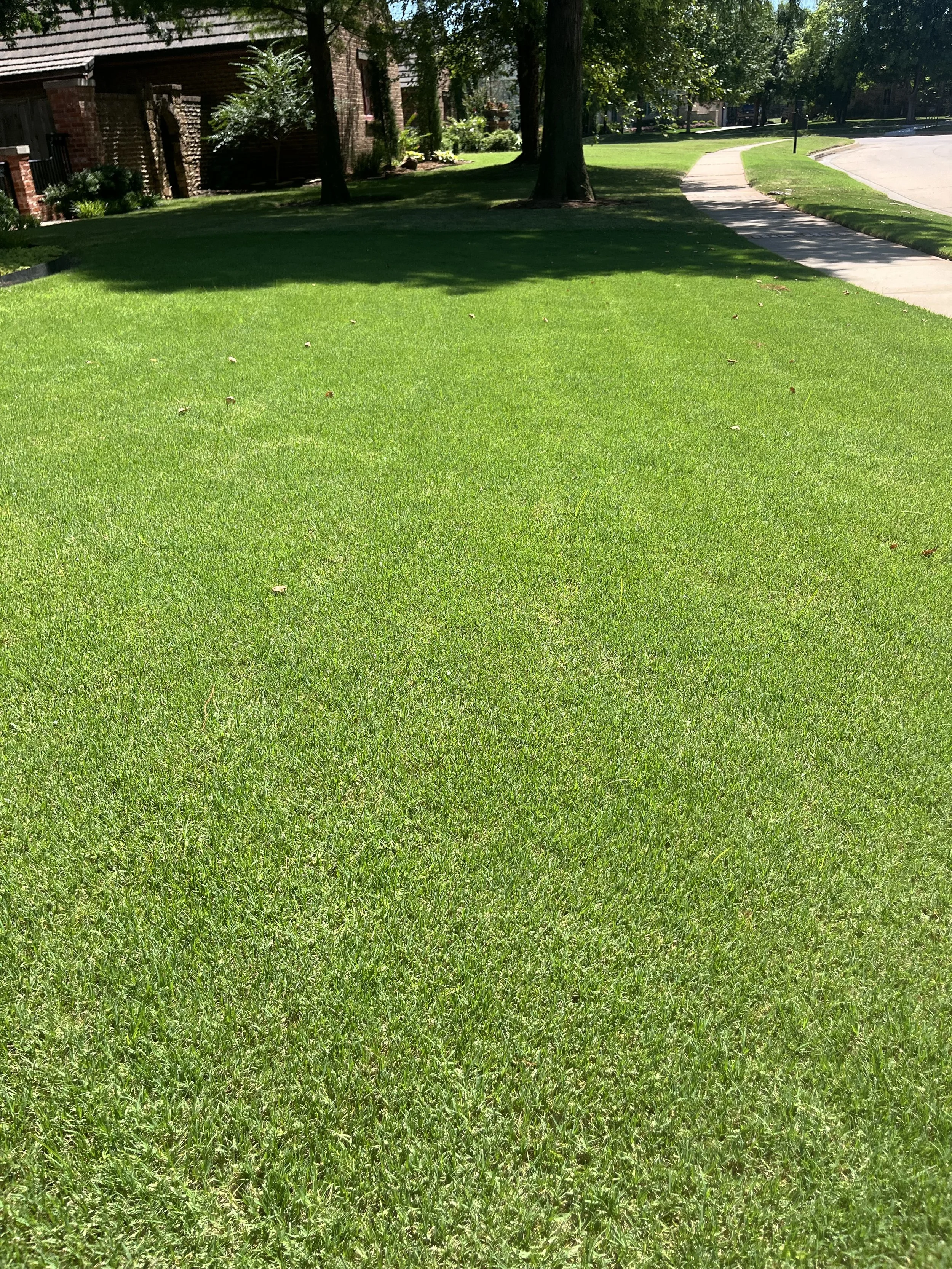Fall…Does My Lawn & Landscape Still Need Fertilizer?
Finally, a morning with the feeling of Fall in the air!
I’m ready for the feeling of fall to hang around, are you?
So, here’s the question we are often asked as temperatures cool, Does my lawn and landscape still need fertilizer?
Short answer: “Yes” and “No” and “No”
A little longer answer:
“Yes, the fertilizer season is over for warm season turf (bermuda & zoysia).”
“No, the fertilizer season is not over for fescue.”
And, no the fertilizer season is not over for trees and shrubs.”
Let’s explore the long answer on why fertilizing cool season turf and trees and shrubs is important this Fall.
Fescue
Fall is the beginning of a new season for fescue lawns.
I’m sure you have noticed as afternoon temperatures became more moderate, fescue lawns started regaining color and growing.
For Fescue, Fall is the same as Spring is for bermuda.
A fertilizer application with a higher nitrogen fertilizer, the first number on the fertilizer bag, applied in the Fall as temperatures cool thickens fescue, encourages new growth and adds a deep rich color to the lawn.
Fall fertilizer applications on fescue will result in a healthier, thicker lawn. And don’t forget, a dense healthy lawn is the best defense against weeds.
Two fertilizer applications with at least 25% nitrogen in the fall, 4-6 weeks apart, is recommended for the best fescue lawn.
If you skip one or both of the fall fertilizer applications on your fescue turf, you are not setting yourself up to have your best lawn in 2026. Even if you are overseeding your fescue this fall, fall fertilizer is especially critical in the establishment of a healthy lawn. Don’t cut corners in the fall when it comes to fertilizing fescue.
If you have a overseeded fescue or are planning to this fall, don’t skip a fertilizer application. New seed grows rapidly and needs plenty of nutrition.
Fescue lawns start their new season in the fall and benefit from two fertilizer applications during the fall.
Fescue lawns that have received fertilizer this fall are adding a rich green color to the landscape.
Fescue can be grown in full sun but it requires a very different fertilizer schedule compared to bermuda.
A healthy, thick and deep green fescue lawn next spring is easier to achieve with when a lawn receives the correct fall fertilizer applications.
The challenge for lawns with both warm season and cool season turf is they require the exact opposite timing of fertilizer applications for them both to thrive.
Why is fertilizer not recommended for Bermuda and Zoysia (Warm Season) now?
Wouldn’t fertilizer keep a Bermuda lawn green longer?
Warm season grasses are at the end of their growing season. In October and November, warm season lawns don’t require nitrogen. With shorter days, cooler days and nights, and the decrease in soil temperature, growth slows, and turf color fades.
Heavy nitrogen fertilizer in October in an effort to maintain color longer into the fall is harmful for bermuda and a catalyst for Spring Dead Spot Disease.
The chances of having Spring Dead Spot Disease next year increases when nitrogen fertilizer is applied to a bermuda lawn in the last 4-5 weeks before the first freeze, which in central Oklahoma is typically the first week of November.
So, if you are thinking because it has been a warm fall your bermuda lawn needs one more shot of nitrogen before the end of the season, don’t do it. You are doing more harm than good.
Spring Dead Spot is a disease that impacts bermuda lawns in the spring as the lawn is coming out of dormancy. One of the catalyst is heavy nitrogen applications in October applied in an effort to keep a warm season lawn green and active late into the fall.
Because bermuda starts to thin out when it receives less than 6 hours of direct sunlight it is common to see lawns with both bermuda and fescue. The problem is you try to fertilize them the same, one will flourish and the other will struggle.
Bermuda, a warm season turfgrass,, performs best when fertilized with higher nitrogen during the summer month and low nitrogen fertilizer in the fall.
With cooler night time temperatures and shorter days, Bermuda lawns are slowing down. Resist the urgent to try keep them green and growing with high nitrogen fertilizer this month.
Problem - Fescue won’t thrive, it will actually struggle to survive, if it is fertilized like bermuda. And the same is true for bermuda. Fertilize bermuda like fescue and the result will be a thin, weak lawn.
For a successful, fescue lawn, you have to think backward from a bermuda lawn.
For a successful bermuda lawn, you must think backward from a fescue lawn.
You can’t fertilize them both the same way and expect them both to respond the same way.
The Good News –
If you subscribe to Hall | Stewart’s 7-Step Lawn Care Program, whether you have bermuda, zoysia, fescue or a combination of turfgrasses, we will make sure each type is receiving the correct fertilizer based on the current season and growing conditions. Our program recognizes that warm season grasses and cool season grasses have very different fertilization timing and needs.
Trees and Shrubs
Plants need nutrients to grow and stay healthy just like your lawn does. Signs of low nutrient levels in your landscape plants are lack of growth, dead or dying twigs and branches, off color leaves, and early Fall leaf drop.
Fertilizer applications improve the appearance of trees and shrubs, increase their vigor and help plants increase resistance to disease and insects.
An application of a complete fertilizer containing nitrogen, phosphorus, potassium and micronutrients is recommended.
The best time to fertilize trees and shrubs is after a heavy frost or freeze in the Fall, and in the spring between March and May.
It is important to avoid fertilizing trees and shrubs in late Summer to early Fall because it may result in a flush of tender new growth that may not have time to mature and will be suspectable to winter injury.
Fall fertilizer applications are good for root development and stored nutrients become available next Spring for new growth. Developing a stronger root system is important. Strong roots give the plant the ability to withstand stress during the season from drought, excess moisture, and heat.
Protect your investment in your landscape trees and shrubs with a fall fertilizer application this year.
The Good News –
If you subscribe to the Hall | Stewart Tree & Shrub Care Program you will receive the important Fall fertilization application for your landscape plants. The program includes four regularly scheduled plant health care visits to keep your trees and shrubs healthy throughout the year:
Dormant oil application to smother overwintering insects.
Early Spring application of systemic insecticide and fertilizer.
Late spring to summer application to minimize insect and disease population during the growing season.
Fall fertilizer application.
All applications are tailored to your specific plant species.
If you need have questions or need help understanding the fertilizer needs of your lawn and landscape, we would love to help.
Lorne Hall
Hall | Stewart Lawn + Landscape
(405)367-3873



















